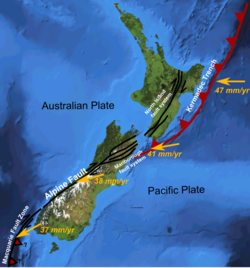List of earthquakes in New Zealand
This is a list of large earthquakes that have occurred in New Zealand. Only earthquakes with a magnitude of 6.0 or greater are listed, except for a few that had a moderate impact. Aftershocks are not included, unless they were of great significance or contributed to a death toll, such as the M 6.3 2011 Christchurch earthquake and the M 7.3 aftershock to the 1931 Hawke's Bay earthquake.
Earthquakes occur frequently in New Zealand as the country is situated in the collision zone between the Indo-Australian and Pacific plates, part of the Pacific Basin Ring of Fire, where many earthquakes and volcanoes occur. Most events occur along the main ranges running from Fiordland in the southwest to East Cape in the northeast. This axis follows the boundary between the Indo-Australian and Pacific plates. Large earthquakes are less common, where the plates are not subducting and the forces are accommodated in different ways.
The largest city within the highest-risk zone is the nation's capital, Wellington, followed by Napier then Hastings. All these cities have experienced severe earthquakes since European settlement. About 14,000 earthquakes occur in and around the country each year, of which between 150 and 200 are big enough to be felt. As a result, New Zealand has very stringent building regulations. The 1929 Murchison earthquake and 1931 Hawke's Bay earthquake led to the development of stricter building codes in New Zealand from 1935.
Quite early on, European settlers were faced with the reality of earthquakes in their new home. On 26 May 1840, the new settlement at Port Nicholson was struck by the first of a number of earthquakes and tremors. Early settlers learned fairly quickly the importance of using appropriate building methods in an earthquake-prone country. The 1848 earthquake, centred in Marlborough, caused great damage to the brick and masonry buildings in Wellington, and the city was rebuilt mainly in wood; consequently it suffered comparatively little damage in the 8.2 magnitude earthquake of 1855, which lifted the land 2–3m. Many buildings in Hastings and Napier were damaged in the 1931 Hawke's Bay earthquake. New building regulations meant that any new buildings constructed afterwards attempted to take earthquake shaking into account in building design.
Pre-19th century
19th century
Information for earthquakes before 1840 are later estimates.
1900–1949
1950–1999
2000–2009
2010–2019
2020–present
See also
- Canterbury Earthquake Response and Recovery Act 2010
- Earthquake Commission
- Geology of New Zealand
- List of disasters in New Zealand by death toll
- List of tsunamis affecting New Zealand
- Shaky Isles – a nickname for New Zealand
- Volcanism of New Zealand
References
Further reading
- Dench, Alison (2005). Essential Dates: A Timeline of New Zealand History. Auckland: Random House. ISBN 978-1-86941-689-8.
- Eiby, G. A. (1957); Earthquakes (London, Frederick Muller) Page 159 has Table of (16) Major Earthquakes in New Zealand 1848–1942, from R. C. Hayes.
- Henderson, J (1937); The West Nelson Earthquakes of 1929, Bulletin No. 55 of Department of Scientific and Industrial Research (Wellington, Government Printer)
- Rogers, Anna (2013) [1996]. The Shaky Isles: New Zealand Earthquakes (2 ed.). Wellington: Grantham House. ISBN 978-1-86934-119-0.
- Wright, Matthew (2014). Living on shaky ground: The science and story behind New Zealand's earthquakes. Auckland: Random House (New Zealand). ISBN 978-1-77553-688-8.
- Michael Upchurch (2021). "He Iwi Rū | Quake Nation: effective interactive data visualisation in the museum". Tuhinga: Records of the Museum of New Zealand Te Papa Tongarewa. 32. Te Papa: 135–151. ISSN 1173-4337. Wikidata Q116264155.

